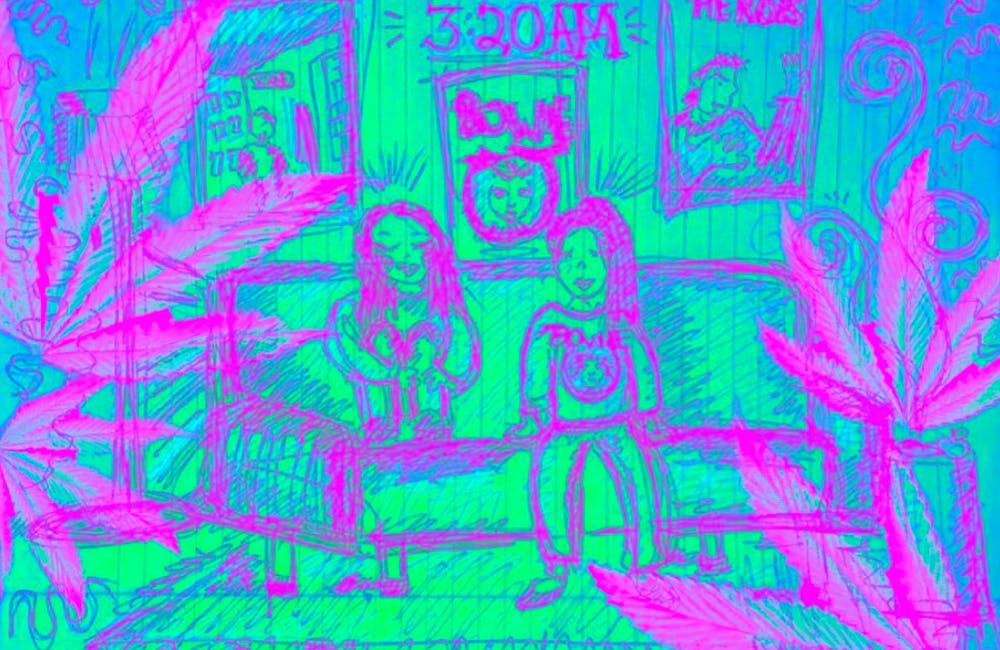“I don’t think I would have been smoking weed to feel better if I hadn’t been just sitting at home all day not doing anything.” Emma* (C’23) says. As we come upon our eighth mind–numbing month of social distancing, her sentiments are especially relatable.
As quarantine draws on, students and adults alike have looked to the most popular illicit substance for comfort—weed. While most small businesses struggled to stay afloat, cannabis sales in Colorado, Oregon, California, Washington state, and Nevada spiked during the first week of lockdown. In fact, Los Angeles released a statement that marijuana dispensaries "provide services that are recognized to be critical to the health" of the city, deeming the once–stigmatized drug an essential business. As many enjoy a recreational puff, some have also indulged in creative pursuits while high.
This was the case for Emma, who began to smoke weed for creative purposes during her freshman year at Penn. “I started using [weed] to write last year just because I had more access to it, and I was smoking at more low–key events. Previously, I felt like I only smoked in parties or large groups of people.” she says. “In college, I just started smoking with myself or one other person. I focused more on how it felt as a headspace, instead of just a social lubricant. And that’s when I started writing when I smoked and smoking to write.”
Using marijuana for creative purposes is nothing new. Amedeo Modigliani, Louis Armstrong, Miley Cyrus and SZA are just a few creative and vocal recreational marijuana users. But, does getting high really increase creativity?
The effects of weed on creativity have not been studied extensively, but we do know that cannabis produces psychotomimetic symptoms. This means that taking a drag from a joint might lead our brains to connect unrelated concepts, which shifts our perception of reality and occasionally increases creative tendencies. This explains why getting high breaks us free from ordinary thinking patterns and increases the chances of creating novel ideas and unconventional art.
“When I’m high I feel like I’m mostly writing poetry or stream–of–consciousness type writing. I definitely find that for poetry I find that it is much easier for me to put things down on paper.” Emma says. “Whereas when I’m sober, I put my thoughts through a lot more filtration and I’m less honest than that type of writing is supposed to be. When I’m high, my thoughts go straight from my head to the paper. That mental space is more conducive to that type of writing.”
More recent research highlights cannabis’s effect on the brain’s frontal lobe. Dr. Alice Weaver Flaherty—a neurologist at the Massachusetts General Hospital and associate professor at Harvard University—found that people with higher levels of creativity have more active frontal lobes. Marijuana use stimulates this area of the brain, leading researchers to draw correlations between getting high and increased creativity.
As with any drug, marijuana must be taken with precaution. It doesn’t come without side effects and affects every individual differently. Take George Carlin, the late comedian best known for his role in the Bill & Ted series. "I do find, that with judicious use, there’s some value in it. But most of the things we use don’t let you leave them alone,” he said in a 1997 interview about his own marijuana use.
When used in moderation, indulging in a high clears the path for artistic catharsis. “I think everyone who makes art while high has a similar experience, where I go back to my work sometimes and not know what I was talking about. But, in the moment, I always know exactly what I’m talking about.” Emma laughs.
*Indicates a name has been changed for anonymity







